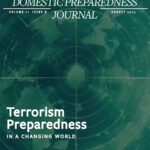
Dan Cotter
Dan Cotter is the Executive Director for the Department of Homeland Security (DHS) Science and Technology Directorate (S&T) Office of Science and Engineering. His prior positions with S&T include serving as the Director of Support to the Homeland Security Enterprise and First Responders Group. Before joining S&T, Cotter held positions as the DHS Chief Technology Officer and as the DHS Geospatial Management Officer. His public sector experience also includes twelve years with the Federal Emergency Management Agency. Cotter’s private sector experience includes acting as the Geospatial Information Technologies Manager for a large engineering firm, as the President of an airborne light detection and ranging company, and as Vice President of a flood zone determination firm. He was elected as a Fellow of the American Association for the Advancement of Science in 2005. Cotter was recognized for his achievements and leadership skills in 2018 when he received the Presidential Rank Award (Distinguished), the Nation's highest award for career members of the Senior Executive Service.

Christina Bapst-Stump
Christina Bapst-Stump is a Senior Advisor for the Department of Homeland Security Science and Technology Directorate Office of Science and Engineering. She has also served various organizations and efforts within the Department, including the National Information Exchange Model, where she set the strategic vision for the program as well as oversaw operational functions, communications, and outreach. Her previous experience includes Robbins-Gioia, ExxonMobil Corporation, and General Electric, Corporate Research and Development. She has a Master of Business Administration from The George Washington University and a Bachelor of Science in Management from Rensselaer Polytechnic Institute.

Ann Lesperance
Ann Lesperance is the Director of the Northwest Regional Technology Center at the Pacific Northwest National Laboratory (PNNL). She has over 30 years of experience as a researcher and project manager, and her primary focus is developing regional programs to accelerate the demonstration and deployment of new homeland security technologies. Lesperance works with state and local emergency responders and public safety officials and builds regional coalitions of emergency management professionals to understand and help prioritize their operational needs and requirements. Lesperance also has a joint appointment as the Director for the College of Social Science and Humanities Programs at Northeastern University Seattle. In this role, she leads efforts to build the Master’s program in Security and Resilience Studies and Urban Informatics.

Rachel A. Bartholomew
Rachel Bartholomew is a Science and Policy Advisor and team lead in the Chemical and Biological Signatures Group at Pacific Northwest National Laboratory (PNNL). She has over two decades of experience applying molecular biology to address national security, policy, and nonproliferation challenges. She has served as principal investigator and project manager for a variety of sponsors, including Departments of Homeland Security, Energy, State, and Defense, engaging with a range of domestic and international stakeholders, such as first responders, law enforcement, customs and border personnel, policymakers, and scientific subject matter experts. In 2023, Bartholomew was named Deputy Director for the Northwest Regional Technology Center, a virtual resource operated by PNNL to support local and regional preparedness, resiliency, response, and recovery. Concurrently, she is the Principal Investigator on projects exploring first-responder technology, emergency management, and emergency operations centers of the future. These efforts are leveraging her decades of experience building relationships and connecting with the first responder community to capture and translate their technical requirements into research and solutions. She received her BA in biology from Case Western Reserve University and PhD in animal physiology from Cornell University, where she was a National Science Foundation pre-doctoral Fellow. Her post-doctoral training was completed at the FBI Laboratory’s Counterterrorism and Forensic Science Research Unit.





